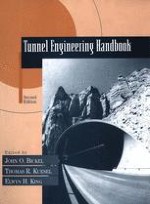1996 | OriginalPaper | Buchkapitel
Cut-and-Cover Tunnel Structures
verfasst von : James L. Wilton
Erschienen in: Tunnel Engineering Handbook
Verlag: Springer US
Enthalten in: Professional Book Archive
Aktivieren Sie unsere intelligente Suche, um passende Fachinhalte oder Patente zu finden.
Wählen Sie Textabschnitte aus um mit Künstlicher Intelligenz passenden Patente zu finden. powered by
Markieren Sie Textabschnitte, um KI-gestützt weitere passende Inhalte zu finden. powered by
Shallow-depth tunnels, such as large sewer tunnels, vehicular tunnels, and rapid transit tunnels, are frequently designed as structures to be constructed using the cut-and-cover method. Tunnel construction is characterized as “cut-and-cover” construction when the tunnel structure is constructed in a braced, trench-type excavation (“cut”) and is subsequently backfilled (“covered”). For depths up to 35–45 ft this method is often cheaper and more practical than underground tunneling, and depths of 60 ft or more are quite common for rapid transit cuts. This chapter discusses the design and construction of the larger cast-in-place concrete structures used as sewer tunnels or transportation tunnels for pedestrian, vehicular, or rapid transit traffic. The tunnel is typically designed as a box-shaped frame, and due to the limited space available in urban areas, it is usually constructed within a braced excavation. Where adequate space is available, such as in open areas beyond urban development, it is often more economical to use open-cut construction.
